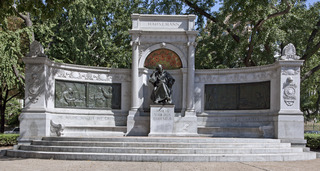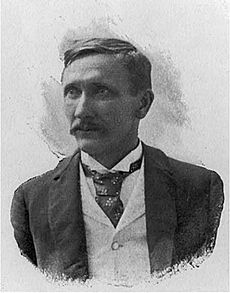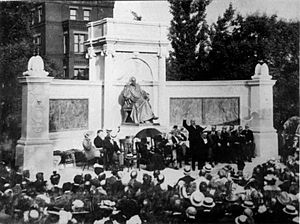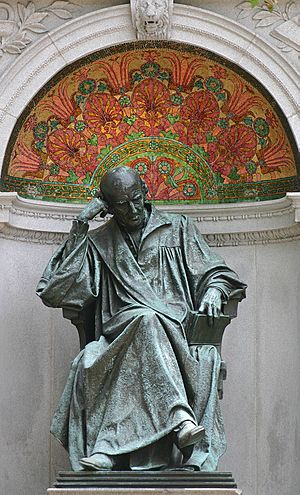Samuel Hahnemann Monument facts for kids
 |
|
| Coordinates | 38°54′26″N 77°02′09″W / 38.907256°N 77.035725°W |
|---|---|
|
Samuel Hahnemann Monument
|
|
| NRHP reference No. | 07001055 |
| Added to NRHP | October 11, 2007 |
| Location | Reservation 64, Scott Circle, Washington, D.C., United States |
| Designer |
|
| Material |
|
| Length | 2.5 feet (0.76 m) |
| Width | 3 feet (0.91 m) |
| Height | 6 feet (1.8 m) |
| Opening date | June 21, 1900 |
| Dedicated to | Samuel Hahnemann |
The Samuel Hahnemann Monument is a special statue in Washington, D.C.. It honors Samuel Hahnemann, who started a type of medicine called homeopathy. You can find it on the east side of Scott Circle, a big traffic circle in the city.
This monument is built in a Classical Revival style. It has a curved stone bench structure, called an exedra, designed by architect Julius Harder. The main statue was made by Charles Henry Niehaus. He also created other famous statues, like the John Paul Jones Memorial in Washington, D.C.
This monument is important because Hahnemann was the first person from another country, who was not part of the American Revolution, to have a statue in Washington, D.C. The monument was officially opened in 1900. Many people helped raise money for it, especially the American Institute of Homeopathy. Important people like President William McKinley attended the dedication. The monument was updated in 2000 and restored in 2011. It was added to the National Register of Historic Places in 2007. The National Park Service takes care of the monument and the area around it.
Contents
History of the Hahnemann Monument
Who Was Samuel Hahnemann?
Samuel Hahnemann (1755–1843) was a doctor from Germany. He created homeopathy, which is an alternative medicine system. He studied chemistry and medicine at the University of Erlangen-Nuremberg. He became a doctor in 1779.
Hahnemann worked in hospitals and asylums. While teaching at Leipzig University, he became unhappy with common medical practices of his time. He disliked treatments like bleeding patients. He wanted to find "natural laws" for medicine. He developed the idea of "like cures like" (similia similibus curantur).
His ideas were new and caused some debate. But Hahnemann kept working on homeopathy. He wrote several books, including The Organon of the Healing Act. He is seen as the most important person in the history of homeopathy. His ideas were very popular in the late 1800s and early 1900s.
Planning the Monument
The idea for a monument to Hahnemann came up in 1881. Dr. James H. McClelland first suggested it. In 1892, the American Institute of Homeopathy (AIH) decided to make the project happen. People who supported homeopathy across the country started raising money. Dr. Nancy T. Williams made the largest donation.
The AIH worked with the National Sculpture Society. They formed a group to pick an artist and design. This group included famous sculptors like Daniel Chester French. They held a competition where 25 different models were shown. This was the first time such models were publicly displayed in the U.S. The group chose the design by Charles Henry Niehaus.
Niehaus (1855–1935) was a German-American sculptor from Ohio. He studied art in Munich, Germany. In 1881, he was asked to create a statue of President James A. Garfield. Niehaus moved to New York City in 1887. He became known for his portrait sculptures.
He made eight statues for the National Statuary Hall Collection in the United States Capitol. His statue of John Paul Jones in Washington, D.C., is also very famous. Niehaus based Hahnemann's face on an older sculpture by David d'Angers.
Getting permission to build the monument in Washington, D.C., was hard. Hahnemann was not American and had never visited the U.S. Supporters asked members of Congress to approve it. President Grover Cleveland did not agree at first.
After President William McKinley was elected, supporters tried again. They finally got approval from Congress on January 31, 1900. Congress also gave $4,000 for the monument's foundation. This made Hahnemann the first non-American, not linked to the American Revolution, to be honored with a statue in Washington, D.C.
A special committee chose the location for the monument. They picked a spot on the east side of Scott Circle. They felt it was perfect to show off the artist's work. Julius Harder was chosen as the architect. The Gorham Manufacturing Company made the statue. The total cost for the monument was about $75,000.
Monument Dedication Ceremony
The monument was officially opened on June 21, 1900. This happened during a meeting of the AIH. Thousands of people came to the ceremony at Scott Circle. Many doctors were there. Special guests, like President McKinley and his wife, sat in front. They both supported homeopathy.
When the president arrived, the United States Marine Band played "Hail to the Chief". Dr. James Bayard Gregg Custis led the event. He said the monument was built "in the hope that from it...truth may be spread."
The monument was then uncovered as the Marine Band played "My Country, 'Tis of Thee". The president of the AIH, Dr. Charles E. Walton, gave the monument to the government. He said it honored Hahnemann's genius and his followers' loyalty. Colonel Theodore A. Bingham accepted the monument for the government. He promised it would be well cared for.
The Marine Band played "The Star-Spangled Banner". Then Attorney General John W. Griggs gave a speech. He said that a scientist like Hahnemann belonged in the park with statues of a warrior and a statesman. He praised Hahnemann for finding truth and fixing errors. The ceremony ended with cheers for the president. Afterward, President McKinley invited about 1,000 guests to the White House.
Recent History and Restoration
On June 21, 2000, exactly 100 years after its first opening, a rededication ceremony was held. During this event, people noticed the monument needed repairs. The mosaic above the statue was crumbling.
Dr. Sandra M. Chase started a fundraising effort. It was called the Hahnemann Monument Restoration Project. Over the next few years, AIH members and the public raised more than $30,000 for repairs. They worked with the National Park Service (NPS).
Conservator Judy Jacob was hired to lead the restoration. The statue was cleaned. The granite was cleaned. The fountain and pedestal on the back were fixed. Bricks around the monument were relaid. A missing oak tree was replaced. The restoration was finished on September 16, 2011. Representatives from the NPS and AIH attended an event to mark its completion.
The monument was added to the District of Columbia Inventory of Historic Sites in 2007. It was also added to the NRHP in 2007. It is part of the Sixteenth Street Historic District, which is also on the NRHP. The NPS owns and takes care of the monument and its surrounding area.
Monument Design and Location
The Samuel Hahnemann Monument is on a small, triangle-shaped piece of land. It is on the east side of Scott Circle in Washington, D.C. It faces west towards the traffic circle. Across the circle, you can see the Brevet Lt. General Winfield Scott statue. The Daniel Webster Memorial is also nearby.
The monument is in a Classical Revival style. It has an exedra, which is a curved bench area. In the center is a seated statue of Hahnemann. The statue is about 6 feet (1.8 meters) tall. Hahnemann is shown wearing long robes. His right leg is crossed over his left. His right arm rests on the chair, with his head in his hand. His left hand holds a book. He looks bald and seems to be thinking deeply.
Above the statue is a colorful ceramic mosaic. It is designed in the Art Nouveau style. There is also a lion's head. On each side of the lion's head are stone reliefs (carvings). The right carving shows a snake around a chalice. The left carving shows an open book and a chemist's bowl.
Columns stand on either side of the statue. A panel above them says "HAHNEMANN". Below the statue, a Latin phrase reads: "SIMILIA / SIMILIBUS / CURENTUR". This means "Likes Are Cured By Like."
On each side of the central statue are two bronze carvings by Niehaus. They are about 4 feet (1.2 meters) tall. The carvings on the left show Hahnemann as a student and a chemist. Below them is a German phrase: "DIE MILDE MACHT IST GROSS", meaning "Gentle Power is Great". The carvings on the right show Hahnemann as a teacher and a doctor. Below them is a Latin phrase: "IN OMNIBUS CARITAS", meaning "In All Things, Charity".
Each end of the exedra has a post with a shield and a lion's head. A large shell is on top of these posts. Four steps lead up to the exedra. The exedra itself is about 25 feet (7.6 meters) tall and 36 feet (11 meters) long. On the back of the exedra, there is a fountain basin. It has a bird-like spout and a carving of two kneeling figures.
Here are some of the words carved on the monument:
- FEC '96 Gorham MFG Co / Founders
- C H Niehaus (on some bronze carvings)
- HAHNEMANN (above the statue)
- SIMILIA / SIMILIBUS / CURENTUR (at the base of the statue)
- AUDE SAPERE (left side of statue)
- NON INUTILIS VIXI (right side of statue)
- IN OMNIBUS CARITAS (below right carvings)
- DIE MILDE MACHT IST GROSS (below left carvings)
- ERLANGEN / DESSAU (left end post)
- COETHEN / LEIPZIG (right end post)
- MCM / CHRISTIAN FRIEDRICH SAMUEL HAHNEMANN / DOCTOR IN MEDICINE / HOFRATH / LEADER OF THE GREAT / MEDICAL REFORMATION / OF THE NINETEENTH / CENTURY / FOUNDER OF THE / HOMEOPATHIC SCHOOL (back of exedra, center)
- PARIS JULY 2 1843 (back of exedra, right)
- MEISSEN APRIL 11, 1755 (back of exedra, left)
See also
 In Spanish: Monumento a Samuel Hahnemann para niños
In Spanish: Monumento a Samuel Hahnemann para niños




